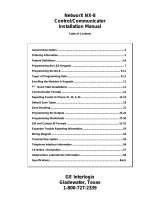
Transmitter Input Types .........................~......................................V.............................. 35
Transmitter Battery Life
...............................................................................................35
programming the Receiverand Transmitters
..................................................................36
Using the ‘lknsmitter Sniffer Mode ................................................................................39
To Either Temporarily or Permanently Removea ZoneFrom the System.................... 39
Deleting a Transmitter Serial Number From a Zonein *56 Mode................................. 39
5800 SeriesTransmitters Table........................................................................................ 40
Installing 5800 Series ~msmitiers .................................................................................4l
Go/No Go Test Mode .......................................................................................................4l
SettingDIP Switcheson the 5827 Transmitter(s) ....................................................... 41
Section 8
RELAY OUTPUTS & POWERLINE CARRIER DEVICES ...................................... 42
Relay/PowerlineCarrier DeviceBasics............................................................................42
Nos. 4204And4229 Output Relay Modules ....................................................................42
4204/4229 Setup ..........................................................................................................42
PowerlineCarrier Detices.................................................................................................43
Wifig Couections .....................................................................................................44
Programming Options Defined .........................................................................................45
Programming Output Relays and Powerline Carrier Devices
........................................47
Section 9.
4285 VOICE MODULE ...................................................................................................5O
Installing the VoiceModule ..............................................................................................5O
General ~ormation .......................................................................................................5O
Mounting The Voice Module
..........................................................................................5o
VoiceModule Wiring ......................................................................................................5l
Caller ID Units ...............................................................................................................5l
Programming The Control For Phone Access..................................................................53
Checkingthe Operation of the 4285 VoiceModule
..........................................................
54
Section 10. EXTERNAL SO~E~ ...............................................................................................55
CompatibleSounders.........................................................................................................55
Somder Comectio~ .........................................................................................................56
Programming For External Souders ............................................................................... 56
Testingthe Sounder
...........................................................................................................57
Section 11. LONG RANGE RADIO ...................................................................................................58
General Information .......................................................................................................... 58
Connection
..........................................................................................................................58
Programming .....................................................................................................................58
Section 12. REMOTE KEYSWITCH
..................................................................................................59
Installing the KeysWitch
...................................................................................................59
RemoteKeysw-itchConnections
.....................................................................................59
programming for the RemoteKeyswitch......................................................................... 61
KeysWitchOperation ......................................................................................................... 62
Section 13. AUDIO
AIAR.M VERIFICATION (AAV) UNIT .........................................................63
General Infomation .......................................................................................................... 63
Wfig Comections ............................................................................................................63
Programming
....................................................................................................................63
Section 14. FINAL POWER UP
.........................................................................................................65
Earth Ground Connections
...............................................................................................65
Connectingthe Back-Up Batie~ ......................................................................................65
Calculating the Battery Size Needed
............................................................................65
Making the Battery Connections
................................................................................... 66
Auxiliary Device Current Draw Worksheet ..................................................................... 66
Section 15. ALPHA DESCRIPTION PROGRAMMING
................................................................ 67
&si@g~ne Descnptirs ...............................................................................................67
Entering Zone Descriptors(in program Menu Mode *82)
............................................... 67
Programming the Descriptors........................................................................................67
Alternate Method for Programming ZoneDescriptors
.................................................69
Adding Custom Words
.......................................................................................................
70
4-




















